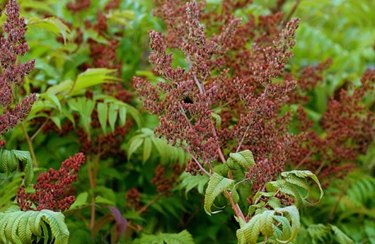
Sumac (Rhus spp.) is a shrub or small tree with many varieties that is often used as an ornamental plant in the home landscape and provides brilliant fall foliage and attractive fuzzy fruits. Hardy in U.S. Department of Agriculture plant hardiness zones 3 to 9, sumac grows slowly from seed but it does spread quickly from sumac sprouts or suckers. Suckers arise from vegetative sprouts attached to the roots of the plant. Each sucker will become another plant. Controlling the spread of sumac may require a targeted herbicide or complex and repetitive mechanical measures.
There is also a poison sumac plant (Toxicodendron vernix, USDA zones 3-8), which causes epidermal distress in those that come in contact with the plant. Note that strategies for how to get rid of sumac trees that involve touching the plants should be done on non-poisonous sumac only. If you are dealing with poison sumac, it is best to use herbicides only and do not touch, dig up or burn the plant.
Video of the Day
Video of the Day
Step 1: Prevent Seed Dispersal
Cut off the flowers in spring. The tiny green flowers are insignificant but will become larger furry berries containing seed. The birds eat the berries and spread the seed, in essence planting it. You can also wait until summer and cut the clusters of berries off the sumac before they begin to ripen. Remove flower or fruit back to the next growing point.
Step 2: Physically Remove Sumac Sprouts
Identify the suckers and dig down until you find the root. Follow the root back to the plant and cut it out. This will remove the existing bud point that would have formed suckers, but temporarily — it will be back. Sumac control has to be done annually in this manner.
Step 3: Apply Glyphosate Herbicide
Prune off the suckers with loppers, leaving a small amount of stem. Use a 20-percent solution of glyphosate mixed with water and spray the stump or stem. Be careful not to spray other foliage as glyphosate is a nonselective herbicide and will kill any plant that it contacts. The herbicide is systemic, which means it will kill the entire plant.
Step 4: Apply Selective Herbicide to Suckers
Use triclopyr herbicide on thin suckers in areas where you can easily treat every sucker. This herbicide will kill the suckers but not the plant unless you treat the parent. Spray triclopyr mixed with horticultural oil at the rate that the packaging recommends. Target the base of the sucker stem. There is no need to cut the suckers prior to treatment, and you should see results within a week.
Step 5: Mow or Cut Back Suckers
Mow off the suckers when they invade the lawn. This is a temporary solution, not an aggressive method of how to get rid of sumac, as the underground root will still sprout. Over several seasons, the constant mowing will reduce the vigor of the sprout, and it may die. However, another may sprout in a different location.
Warning
Follow all safety precautions recommended by the manufacturer when using herbicides.
Things You'll Need
Pruners
Shovel
Loppers
Spray bottle
Glyphosate
Water
Triclopyr
Horticultural oil
Mower